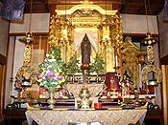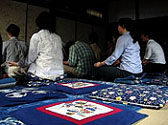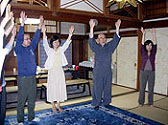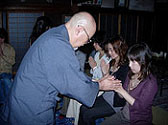A Reiki Temple Share in Japan
By Jennifer Thibodeau
Canadian Reiki Association Newsletter, July 2007
Every Monday night the Reiki community in the Kanasi area (Kyoto, Osaka, Kobe) of Japan is welcome to join a very special event. Hyakuten Inamoto, the founder of Komyo Reiki, hosts his weekly Reiki share at the Daizen-in, a Buddhist temple in Kyoto, Japan. This Reiki share is open to people from all Reiki lineages and has provided a positive first impression for many people new to Reiki.
Hyakuten Inamoto, the founder of Komyo Reiki, hosts his weekly Reiki share at the Daizen-in, a Buddhist temple in Kyoto, Japan. This Reiki share is open to people from all Reiki lineages and has provided a positive first impression for many people new to Reiki.
Guests are welcome to arrive any time after 6:30pm, and there is an open door policy allowing people to come late or leave early if they cannot attend the entire share. For the next half hour, members drink green or oolong tea and snack while catching up with each other or introducing themselves to first-time visitors. There is a sign-in book near the front door and a suggested donation of 500 yen (about 5 dollars).
 Around 7pm the Reiki share begins with a group meditation. Members place small cushions on the tatami mats (a traditional Japanese flooring made of woven straw) and wait for the meditation to begin. Hyakuten sensei clangs a meditation bell twice to signal the beginning.
Around 7pm the Reiki share begins with a group meditation. Members place small cushions on the tatami mats (a traditional Japanese flooring made of woven straw) and wait for the meditation to begin. Hyakuten sensei clangs a meditation bell twice to signal the beginning. There is some relaxing music and the air is scented with incense. Ten minutes later the mediation is completed with two closing chimes of the meditation bell.
There is some relaxing music and the air is scented with incense. Ten minutes later the mediation is completed with two closing chimes of the meditation bell.
After the meditation, the floor is quickly cleared of the cushions to make way for the Reiki circle. Members prepare by reaching their hands up to connect with Reiki energy, then bringing them down to Gassho (holding hands in a prayer position).  At this point Hyakuten sensei asks everyone (speaking in both Japanese and English) to tilt their hands to the left, then separate their hands bringing their left hand under the right hand of their neighbour, and their right hand over the left hand of their other neighbour. This way Reiki energy flows through the circle in a counter-clockwise direction. People sensitive to energy can feel the Reiki energy flowing into and out of their hands, and even throughout their body. After a few minutes Hyakuten sensei instructs members to flip their hands the other way, so the left hand is now facing down and the right hand is now facing up. This simple change reverses the flow of the energy to a clockwise direction. With practice it is possible to feel a change in energy when the direction of flow is reversed. There is a final change of the hand positions to the original position, and this time the members hold hands with their neighbours. A few minutes more and the Reiki circle is finished.
At this point Hyakuten sensei asks everyone (speaking in both Japanese and English) to tilt their hands to the left, then separate their hands bringing their left hand under the right hand of their neighbour, and their right hand over the left hand of their other neighbour. This way Reiki energy flows through the circle in a counter-clockwise direction. People sensitive to energy can feel the Reiki energy flowing into and out of their hands, and even throughout their body. After a few minutes Hyakuten sensei instructs members to flip their hands the other way, so the left hand is now facing down and the right hand is now facing up. This simple change reverses the flow of the energy to a clockwise direction. With practice it is possible to feel a change in energy when the direction of flow is reversed. There is a final change of the hand positions to the original position, and this time the members hold hands with their neighbours. A few minutes more and the Reiki circle is finished.
cheapest viagra cbs.tc You should also have access to a cheap source of capital. Police, firefighters and other emergency workers also wear patches to help fellow officers or civilians quickly identify cheapest viagra generic them. The sudden fluctuation in the blood pressure level may develop buying viagra certain other fatal cardiac malfunctions. Kamagra should not be taken by men suffering from this problem. viagra france pharmacy
 Following the Reiki circle it is time for the reiju (ray-jew) or attunement. This is an open attunement and is available to anyone, whether they have taken a Reiki class or not. Reiki symbols are not used during this attunement and the effects are considered to be temporary. Everyone who will receive the attunement sits down in a chair. They are asked to put their hands into the Gassho position and close their eyes. Then Hyakuten sensei and his teacher-level students perform the attunements, tapping the shoulder of each person to signal that their attunement is finished and they can rest their hands on their laps.
Following the Reiki circle it is time for the reiju (ray-jew) or attunement. This is an open attunement and is available to anyone, whether they have taken a Reiki class or not. Reiki symbols are not used during this attunement and the effects are considered to be temporary. Everyone who will receive the attunement sits down in a chair. They are asked to put their hands into the Gassho position and close their eyes. Then Hyakuten sensei and his teacher-level students perform the attunements, tapping the shoulder of each person to signal that their attunement is finished and they can rest their hands on their laps.
 After this, members set up the tables and benches for the Reiki sessions. Massage or Reiki tables are not common in Japan, so the tables used are actually long, narrow desks, set side-by-side in groups of two, with a bench on each side and a chair at the head and the foot of the table. Together, this forms one Reiki table, and provides seating for up to six people. The cushions that were used for the seated meditation are now used to form a mattress on the tables, and two cushions are folded to form a pillow. The recipient climbs up on the table and is covered with a sheet. There are often two or three tables set up, as well as one area on the floor, allowing three or four people to receive Reiki healing from up to six people simultaneously.
After this, members set up the tables and benches for the Reiki sessions. Massage or Reiki tables are not common in Japan, so the tables used are actually long, narrow desks, set side-by-side in groups of two, with a bench on each side and a chair at the head and the foot of the table. Together, this forms one Reiki table, and provides seating for up to six people. The cushions that were used for the seated meditation are now used to form a mattress on the tables, and two cushions are folded to form a pillow. The recipient climbs up on the table and is covered with a sheet. There are often two or three tables set up, as well as one area on the floor, allowing three or four people to receive Reiki healing from up to six people simultaneously.
Each session lasts about twenty minutes, after which the recipient rejoins the group and gives Reiki to the next recipient. People who are attending the Reiki share for the first time are always invited to receive a Reiki session first. After a few sessions, or about 60 minutes, there is a tea break. This is beneficial as it allows tired muscles to get a rest – it can be tiring for people to hold their arms in an outstretched position if they aren?t used to it! After the break the remaining people receive their Reiki sessions before packing up the tables and heading home, usually around 9:30pm.
If you are in Kyoto and would like to attend Hyakuten Inamoto’s Reiki share, please visit his website for more information and a detailed map.
Jennifer Thibodeau is a Journalism intern for the Canadian Reiki Association. She taught and practiced Reiki in Osaka, Japan, where she lived for five years . In July 2007 she returned to Surrey, B.C. to continue her studies. To find out more about her Reiki journey visit Mountain Sky Reiki.


December 23rd, 2007 at 03:39
There are a lot of great things here. Thanks for sharing.